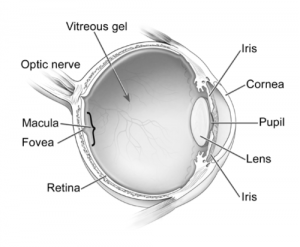Eye Health – Medicare and Medicaid Facts and Resources
talkingMEDICARE; News to Use for Agents in the Senior Market
| The most common eye diseases and conditions that affect older adults include age-related macular degeneration (AMD), cataract, diabetic retinopathy, dry eye, glaucoma, and low vision. Many of these diseases and conditions do not have noticeable symptoms in their early stages, but they can be detected through a comprehensive dilated eye exam. Treatment is most effective when an eye disease is diagnosed early.
Source:https://www.nei.nih.gov/health/eyediagram
|
 |
Medicare Part B Covers These Preventive and Diagnostic Eye Exams
Eye Exams, if You Have Diabetes | Medicare Part B covers eye exams for diabetic retinopathy once a year if you have diabetes. https://www.medicare.gov/coverage/eye-exams-for-diabetes
Glaucoma Tests | Medicare Part B covers glaucoma tests once every 12 months if you’re at high risk for glaucoma. https://www.medicare.gov/coverage/glaucoma-tests
Macular Degeneration Tests and Treatment | Medicare Part B may cover certain diagnostic tests and treatment (including treatment with certain injected drugs) of eye diseases and conditions if you have age-related macular degeneration (AMD). https://www.medicare.gov/coverage/macular-degeneration-tests-treatment
NOTE:
- Medicare doesn’t cover eye exams (sometimes called “eye refractions”) for eyeglasses or contact lenses.
- Medicare doesn’t usually cover eyeglasses or contact lenses.
- However, Medicare Part B (Medical Insurance) helps pay for corrective lenses if you have cataract surgery to implant an intraocular lens. Corrective lenses include one pair of eyeglasses with standard frames or one set of contact lenses.
https://www.medicare.gov/coverage/eyeglasses-contact-lenses
Common Age-related Eye Diseases and Conditions
 |
Age-related Macular Degeneration (AMD) AMD is a disease associated with aging that gradually destroys sharp, central vision. Central vision is needed for seeing objects clearly and for common daily tasks such as reading and driving.https://nei.nih.gov/health/maculardegen/armd_facts |
|
 |
Cataract A cataract is a clouding of the lens in the eye. Vision with cataract can appear cloudy or blurry, colors may seem faded and you may notice a lot of glare.https://nei.nih.gov/health/cataract/cataract_facts |
|
 |
Diabetic Eye Disease Diabetic eye disease is a complication of diabetes and a leading cause of blindness. The most common form is diabetic retinopathy which occurs when diabetes damages the tiny blood vessels inside the retina.https://nei.nih.gov/diabetes/ |
|
 |
Glaucoma Glaucoma is a group of diseases that can damage the eye’s optic nerve and result in vision loss and blindness. It is usually associated with high pressure in the eye and affects side or peripheral vision.https://nei.nih.gov/glaucoma/ |
Resources and Tools
Vision and Aging: Social Media Toolkit: https://www.nei.nih.gov/nehep/programs/visionandaging/social-media
Vision and Aging Resources: https://www.nei.nih.gov/nehep/programs/visionandaging
National Eye Institute: https://www.nei.nih.gov/health
Information on Prevent Blindness: https://www.preventblindness.org/medicare-benefits-and-your-eyes
Social Security Publication: “If You’re Blind Or Have Low Vision – How We Can Help”: https://www.ssa.gov/pubs/EN-05-10052.pdf

